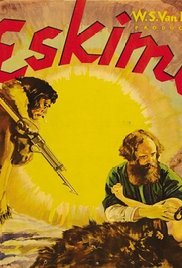
ESKIMO
US, 1933, 117 minutes, Black and white.
Edgar Dearing, Peter Freuchen, Edward Hearn, Joe Sawyer, Mala a.k.a. Kripik, (Ray Mala), Lotus Long.
Directed by W.S.Van Dyke.
In the late 1920s, documentary maker, Robert Flaherty, made a classic, Nanook of North, a film chronicling the lives of the Eskimo. At the same time, there were documentaries about the South Seas, including Moana and White Shadows in the South Seas.
This film, based on stories by writer Peter Freuchen, who appears in the film, was made during 1932 and 1933 on location, under the direction of the prolific W.S. Van Dyke, who was to make a great number of still popular in MGM films from the 1930s into the 1940s.
The black-and-white photography is authentic in the Arctic, in the snow and ice, in the villages with the igloos, as well as on the fur traders’ base. (A number of the sequences were re-enacted in front of rear projection scenery, looking very obvious now). The photography is striking for its time and the way that it was put together, its editing, and the first Oscar awarded for editing.
While many of the Eskimo, speaking their Inuit language in the film (having subtitles), a number of the leading roles are taken by actors, especially Mala, the hunter, played by a Canadian with Inuit background, Raid Wise, who appeared in a number of films using the name Ray Mala. The fur traders and the fishermen as well as the Canadian Mounties are played by actors who speak English.
The photography on location and the use of Inuit helped to give the film its semi-documentary tone.
Like the films of the South Seas, the film is critical of the coming of the white man, the attitudes of the whites in terms of exploitation, greed, using and abusing the local people. One of the fisherman is particularly loathsome, doing deals with Mala, encouraging the fishing and the hunting but taking Mahler’s wife, raping her, getting her drunk and letting her loose in the snow.
In come the Mounties, trying to establish some law and order, with justice for Mala against the fisherman. They travel with him, but their commanding officer is a by-the-book policeman and, while in some ways sympathetic to Mala and his violent reaction to the treatment of his wife, killing the fisherman, he still demands that the Mounties arrest him and bring him back to Justice.
This provides a long journey for the officials, interactions with Mala, trying to communicate in broken Inuit, understanding his code of ethics, his point of view, prepared to let him go.
So, the film serves as an indictment of western colonialisation of these frontiers, the attitude of those who went in, the motivations of greed which led to violence and exploitation, and the victimisation of the local people, inducing them to trade for guns, which had many deadly repercussions for them and their culture.
A film worth seeing for its presentation of the Inuit and the whites but also a means of becoming aware of what consciousness there was at this time in Hollywood, of the repercussions of this kind of colonial exploitation.